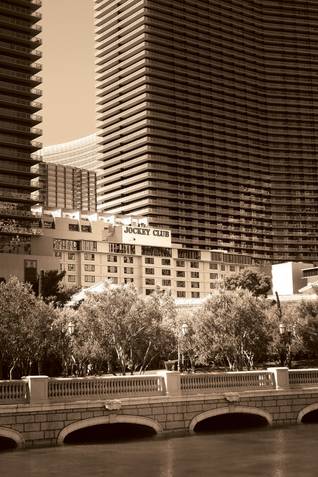
The Jockey Club, a timeshare/condominium property nestled between the Cosmopolitan and CityCenter, isn’t quite as shiny and new as its neighbors.
Friday, Aug. 12, 2011 | 2 a.m.
Jockey Club
Beyond the Sun
View from the Jockey Club
The room was booked over the phone because the website couldn’t handle a same-day reservation. Valet parking cost $20 because the attendant couldn’t break a $5 bill and, yes, they actually charge. Our belongings were dragged through a Byzantine maze of non-ADA-compliant steps and hallways to get to the bank of elevators that take guests to their rooms.
And that’s when the adventure really began.
“Our guest elevators are under repair. Please use the service elevator,” the lime-green sign announced. “We apologize for any inconvenience.”
And so, around the corner I went to line up for the tiny service elevator, which couldn’t hold more than a couple of people and their luggage. But it was worth the wait, if only because it delayed my arrival in a spacious but sad one-bedroom suite with red dotted carpet, a paisley couch and one of those thick, maroon motel-room bedspreads that you just know is a Petri dish for germs. Also, the stale air was a bouquet of hard-to-identify aromas, one of which was most certainly Marlboro despite the fact that the place claims to be nonsmoking.
“Oh man,” I tweeted. “The staycation from hell well under way. The elevators are busted, the room smells like rotted pumpkin.”
A few minutes later, my partner, Miles, texted a private response: “Seriously? Why do we have to stay there, again?”
Because I had always wanted to. But that was kind of a lie. In fact, it never occurred to me to have anything at all to do with the Jockey Club until about four years ago when those two squat, chalk-colored boxes of time shares began to be swallowed up by New Vegas in an epic way. The Bellagio emerged to the north in the 1990s, but that had merely replaced the Dunes. Otherwise, the place remained largely unmolested by progress until the skyscrapers of CityCenter and Cosmopolitan began crowding around it like concrete-and-glass bullies.
Yet there was more to this than idle fascination. I had come to believe that the odd eyesore that is the Jockey Club, seated amid all that opulence, was a significant symbol of what would someday prove to be the gravest problem with CityCenter and several other developments along the Strip. The Jockey Club is a decayed anachronism, but it is also as forever as a diamond.
There are 14,000 different time-share owners and about six dozen full-share owners at 3700 Las Vegas Blvd. South, a nice, round number of an address that denotes its seniority. That population guarantees the Jockey Club will never be bought out or redeveloped in any meaningful way.
•••
Forney Smith and his business associates had this nifty idea in 1972 that what the Strip needed were apartment buildings to house all those thousands of casino employees. It was a Nixon-era version of what we now know as New Urbanism, a notion that there’s virtue and/or utility in dense development where residents can “live, work and play,” as the wonks intone. Smith built Jockey Club to deploy a primitive version of this concept, and he discovered pretty fast that with a few precious exceptions — New York chief among them — the idea fails because, to hear Smith tell it, “Little did I know, you don’t live where you work.”
The Jockey Club was born as only the third condominium project in the state, but buyers began asking Smith to establish a rental program immediately after closing on their units. (They started at $24,000 then, or about $124,000 today, adjusted for inflation.) The people who had bought the units had, by and large, no intention of residing there, nor were they Strip employees shortening their commutes. They were flippers.
“From 1974 to 1977, we operated basically like a hotel,” Smith said. Caesars Palace or the Las Vegas Convention Center would rely on the 348-unit place as a primo location for room blocks during peak events. “People didn’t live there.”
In 1977, the developers took back the last 20 units, which hadn’t been closed on, and tried out a newfangled business model never attempted in Nevada: The time share. Folks could buy a particular week in a particular unit and then pay a yearly maintenance fee that generally amounted to a fraction of what a traditional hotel room for a week might cost. In those days, the time-share industry wasn’t quite so efficiently international — nowadays, properties are often part of large networks where owners can exchange their time in one location for time in other destinations — but the idea caught on, and there are now more than 200,000 time-share units in Las Vegas.
It took until 1993 for the Jockey Club to sell out every last week (each unit in a time-share represents 52 weeks for sale), in part because buying the condos back from the owners was an incremental process. And there remain 78 full owners, a handful of whom actually live there.
Of course, there’s still a rental program. Weeks go unused, so vacationers like me can hop online or call up and book rooms like we would at any other hotel in the city. Which is how I found myself acclimating to the gruesome stench of my seventh-floor suite while gazing out at a surprisingly decent view of the corner of Flamingo and the Strip.
•••
I actually began working on this story more than 18 months ago, in the weeks after CityCenter opened and Cosmo loomed as the Next Big Thing. But Smith, a gruff and defensive fellow with a hippie-esque untamed white beard who rules this fiefdom into his ninth decade, hung up on me back then. Just before he did so, he told me I would have to wait until after Cosmopolitan opened to write about the Jockey Club.
Of course, I didn’t have to, but I did anyway. The Cosmo wouldn’t even exist had Smith and his partner not sold off a chunk of their Strip-fronted property to other developers who were supposed to open a casino. Gaming chips were made, too, for the Jockey Club Casino, but the project failed before it began, and a few years later the original Cosmo developers took over. Those never-deployed gaming chips, by the way, are still for sale on eBay.
Officially, both sides of the weird Cosmo-Jockey Club relationship are all smiles. Theoretically, the Jockey Club is a sort of crazy-uncle-in-the-attic to hip, lush Cosmo — attached by a set of elevators hidden in a nook of the casino to which even many Cosmo employees have difficulty providing directions.
Cosmo CEO John Unwin, in a preopening interview, told me they welcome their neighbors to partake in the new resort’s offerings, including access to their sparkly rooftop pools. During construction, Cosmo paid for a valet service to park Jockey Club guests’ cars at Planet Hollywood because they took over the time-share’s longtime surface parking, and now that it’s open, there’s a large expanse of choice parking spaces in Cosmo’s garage dedicated to Jockey Club guests. Attendants are serious about enforcing that, too; I was chased down at a Cosmo garage elevator by one who forced me to move my car when I had accidentally put it in a Jockey Club space.
And Smith feels that Cosmo provides many things he, as a developer, failed to deliver: “They gave us amenities that we have needed and longed for the 30-some years we’ve been here. We had promised to build another tower and put restaurants and stuff like that in. We couldn’t give them that, but now with the Cosmopolitan, they have everything they want.”

John Unwin
Yet there’s clearly more to it. The Jockey Club’s swimming pool was once an open-air space, but sunbathers there are liable to earn checkerboard tans thanks to netting that serves as a ceiling. It was put in place to shield pool-users from construction debris and remains because Cosmo guests occasionally drop stuff from the open-air balconies. At night, it is lit up with a lattice of light bulbs that give it a vaguely California backyard feel, but the terrace has become the sole smoking area for Jockey Club guests not brazen enough to pollute their rooms as well as a path between the property and elevators that lead to both the parking garage and Cosmo’s casino.
In January, when we stayed at the then-brand new Cosmo with our dogs, Black, Jack and Aces, more than one employee offered this helpful tip for taking our dogs to do their business: Go to a concrete alley just north of the Jockey Club pool. Ouch.
It’s not that the Jockey Club is a totally miserable place to stay. There are some rather charming aspects to it, not the least of which is the price. It cost us about $80 for a same-day reservation on a mid-July night when Cosmo was charging $210, Bellagio was $169, Aria was $129, Vdara was $109 and Paris Las Vegas, Bally’s and Planet Hollywood were sold out.
That’s a steal, and it includes use of a vast, free DVD lending library, free popcorn and a well-stocked convenience store open until 11 p.m. There are shuttles to proper grocery stores every other day or so, too, and free movie nights. Each unit has a fully equipped kitchen and, if you can look past Bellagio’s parking garage, it’s quite a view of sunrise after a fitful night on that spongy excuse for a bed. The staff is superfriendly and helpful without being touchy-feely. And far from being a haven for geezers, as I expected, there was a diverse array of large families, many of whom are second- or third-generation owners who inherited their time shares.
But this version of a hotel is nothing like the opulence that surrounds it. The Jockey Club is undergoing its once-a-decade renovations right now, so I asked Smith what it would be like when that was over. He asked again which unit I had stayed in, then told me that room had already been redone.
“Didn’t it look new?” he said, earning a confused, blank look from me. “Well, if you didn’t see what it looked like before, you wouldn’t know.”
As luck would have it, the week we stayed at the Jockey Club coincided with the Jockey Club’s time share and condo board meetings. Signs throughout the complex invited owners and guests to attend, so I went to one. Later, I’d be accused of being sneaky, but it was a publicly posted meeting and I was a paying guest of the hotel.
It was a typically stuffy affair, the standard-issue subjects of every HOA board. There were discussions about costs of various purchases and, as usual, the blather of one or two self-important jerks kvetching over such minutiae as whether so-and-so was properly identified in last month’s minutes.
Yet I was roused from my stupor by one discussion in particular over how to address various complaints about the Cosmo. Much of it was mundane — exposed drain pipes and wiring — but also, Cosmo had decided not to make good on a promise to beautify and light the narrow sidewalk that Jockey Club visitors use to get to the Strip.
“I have been out here many times at night, and ladies are not going to walk down that walkway,” one board member said. “They don’t. If you come here at night, you’ll see everybody walks right down this road (rather than the designated sidewalk). Now, in my opinion, if people are careful, it is OK. It is the only alternative we have.”
That’s the problem, you see, of getting boxed in. Smith indicated at the meeting that little could be done. He had no comment about it in our interview a week later, and Cosmopolitan also did not have a comment.
•••
Assuming the Cosmo is a net positive — and most Jockey Club guests seem to think it is, give or take the navigational challenges and how hard it has become to fight Strip auto traffic — it doesn’t quite deliver the “everything they want” that Smith said.
That is, if what “they” want is to sell out, as Paula Edens of Salt Lake City does. Her mother bought their share in the 1970s for $13,000, and the descendants are on the hook for $621 a year in maintenance fees. Edens insisted that about four years ago, a “voting sheet” was sent to owners asking about interest in selling out to the Cosmo, but some entrenched condo owners refused to budge and the deal was lost. “They were going to pay a fairly hefty price, and now the value has plummeted. That made it so all the rest of us could not sell our interest of it.”
Smith disputes that such a thing ever happened: “We can’t even get 14,000 people to respond to anything. There’s no way in heck we could ever get 14,000 owners to agree to sell. That was a question every year at the owner meeting when Steve Wynn owned the Bellagio. Every year, somebody would pop up and say, ‘When is Steve Wynn going to buy us out?’”
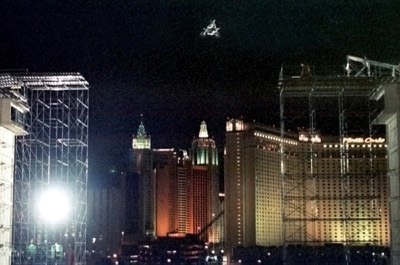
Daredevil Robbie Knievel jumps 130 feet through the air in a rooftop-to-rooftop jump between the 16-story twin hotel towers of the Jockey Club Thursday, Feb. 4, 1999. The stunt, called "Robbie Knievel Building-to-Building Death Jump Live," was televised by the FOX network. The distance was not a record but the run-up room and landing room was short - only 220 feet to get up to speed and 220 feet to stop on the other side.
In fact, Wynn never tried, even as what was then Mirage Resorts acquired the rest of the neighborhood, said Alan Feldman, vice president of MGM Resorts, who was a spokesman for Wynn in the 1990s. “You would actually have to buy every share,” Feldman said. “It isn’t impossible, but it’s very involved. The process wasn’t considered worth it.”
And therein is the conundrum. As much as journalists, historians and nostalgists complain about the ephemeral and historically disrespectful nature of the Strip, that constant change is the secret to the destination’s success. The ability to take a canvas, wipe it clean and dream anew has long been the engine that has demanded the world’s repeat visitation. We may presently be in a prolonged slump — and the newer properties may have been built to last longer than a few decades — but at some point, someone will want to re-envision what’s there today, as unthinkable as it may seem. The folks from Controlled Demolition Inc., the company that has executed every major resort demolition, once told me they have preliminary plans ready to go for the implosion of almost every casino on the Strip.
But not the Jockey Club. No matter how out of place it may be, no matter how decrepit it ever gets, it is an unmovable object. And so, too, are all these now-beautiful condo-hotel projects that account for thousands of individual owners who would need to be persuaded to sell.
“We don’t mind,” Smith said of being surrounded, crowded or sneered upon for not having the beauty or modernism of the Jockey Club’s neighbors. “We’re not going anywhere.”
A longer version of this story originally appeared in Las Vegas Weekly, a sister publication of the Sun.

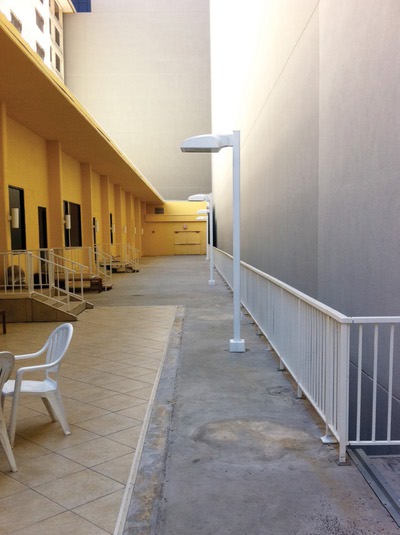
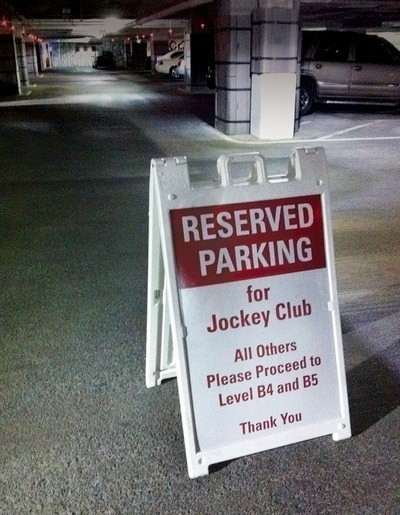
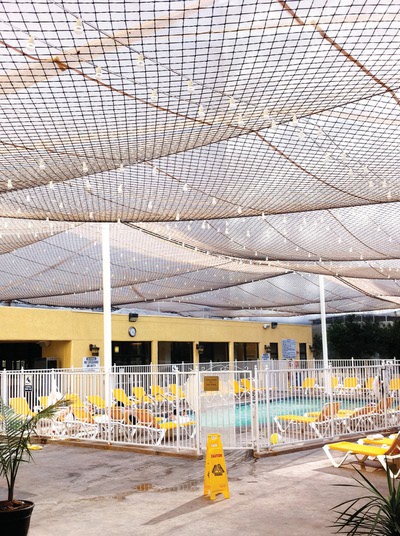

Join the Discussion:
Check this out for a full explanation of our conversion to the LiveFyre commenting system and instructions on how to sign up for an account.
Full comments policy